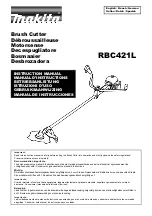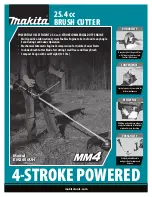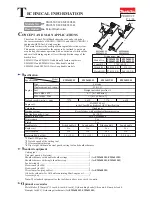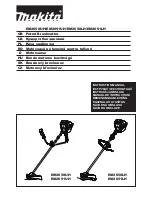
37
cause injury beyond immediate area of operation.
•
Hold the power tool by insulated gripping surfaces only, when performing an operation where the
cutting accessory may contact hidden wiring or its own cord.
Cutting accessory contacting a “live”
wire may make exposed metal parts of the power tool “live” and could give the operator an
electric shock.
•
Position the cord clear of the spinning accessory.
If you loose control, the cord may be cut or
snagged and your hand or arm may be pulled into the spinning wheel.
•
Never lay the power tool down until the accessory has come to a complete stop.
The spinning
wheel may grab the surface and pull the power tool out of your control.
•
Do not run the power tool while carrying it at your side.
Accidental contact with the spinning
accessory could snag your clothing, pulling the accessory into your body.
•
Regularly clean the power tool’s air vents.
The motor’s fan will draw the dust inside the housing
and excessive accumulation of powdered metal may cause electrical hazards.
•
Do not operate the power tool near flammable materials.
Sparks could ignite these materials.
•
Do not use accessories that require liquid coolants.
Using water or other liquid coolants may
result in electrocution or shock.
KICKBACK AND RELATED WARNINGS
•
Maintain a firm grip on the power tool and position your body and arm to allow you to resist
kickback forces. Always use auxiliary handle, if provided, for maximum control over kickback or
torque reaction during start-up.
The operator can control torque reaction or kickback forces, if
proper precautions are taken.
•
Never place your hand near the rotating accessory.
Accessory may kickback over your hand.
•
Do not position your body in line with the rotating wheel.
Kickback will propel the tool in direction
opposite to the wheel’s movement at the point of snagging.
•
Use special care when working corners, sharp edges etc. Avoid bouncing and snagging the
accessory.
Corners, sharp edges or bouncing have a tendency to snag the rotating accessory
and cause loss of control or kickback.
•
Do not attach a saw chain, woodcarving blade, segmented diamond wheel with a peripheral gap
greater than 10 mm or toothed saw blade.
Such blades create frequent kickback and loss of
control.
•
Do not “jam” the wheel or apply excessive pressure. Do not attempt to make an excessive depth
of cut.
Overstressing the wheel increases the loading and susceptibility to twisting or binding of
the wheel in the possibility of kickback or wheel breakage.
•
When wheel is binding or when interrupting a cut for any reason, switch off the power tool and
hold the power tool motionless until the wheel comes to a complete stop. Never attempt to
remove the wheel from the cut while the wheel is in motion otherwise kickback may occur.
Investigate and take corrective action to eliminate the cause of wheel binding.
•
Do not restart the cutting operation in the workpiece. Let the wheel reach full speed and carefully
re-enter the cut.
The wheel may bind, walk up or kickback if the power tool is restarted in the
workpiece.
•
Support panels or any oversized workpiece to minimize the risk of wheel pinching and kickback.
Large workpiecees tend to sag under their own weight. Supports must be placed under the
workpiece near the line of cut and near the edge of the workpiece on both sides of the wheel.
•
Use extra caution when making a “pocket cut” into existing walls or other blind areas.
The
protruding wheel may cut gas or water pipes, electrical wiring or objects that can cause kickback.
SAFETY INSTRUCTIONS FOR LASER
•
Keep children away from the laser. Improper use can result in permanent eye damage.
•
The laser power cannot be increased. The manufacturer cannot accept liability for any personal
injury and/or material damage resulting from failure to follow these safety instructions.
•
Never point the laser beam at people or animals, or reflecting surfaces. Even low power laser can
cause permanent eye damage. Never go within the range of the laser.
•
Remove the batteries from the machine if it is not going to be used for three months, or more, to
avoid damage caused by battery leakage.
•
None of the parts on the laser unit can be maintained by the user. Never attempt to dismantle or
repair the unit yourself.








































